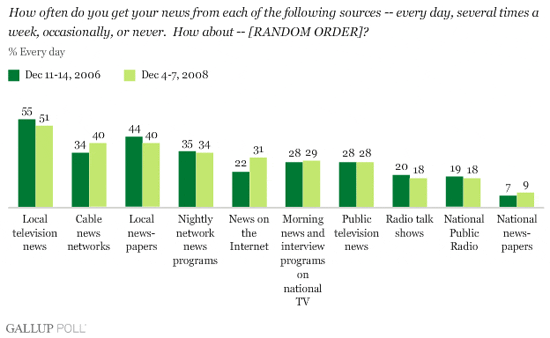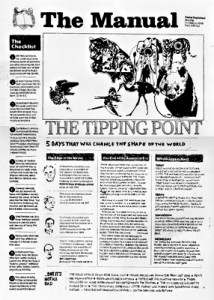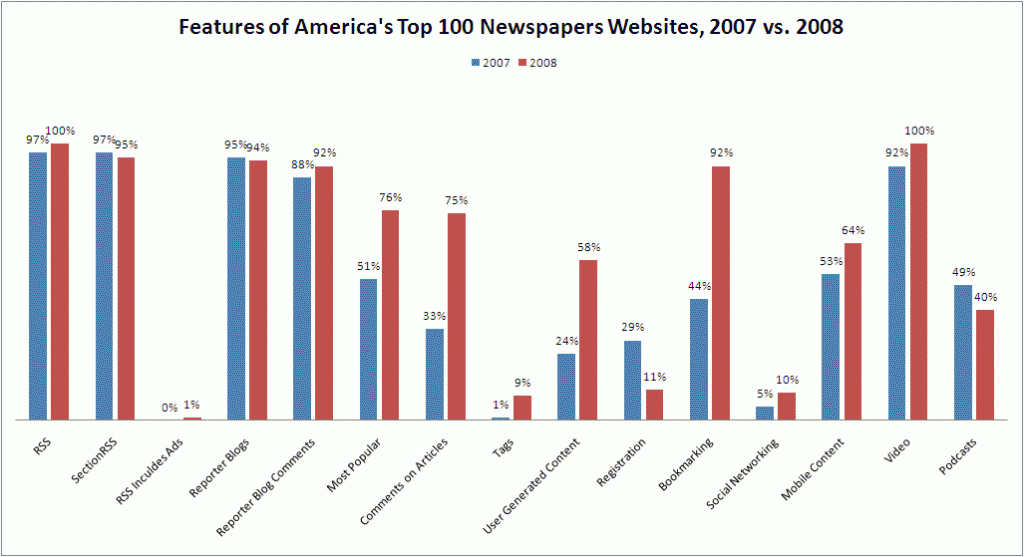Downturn Hits Ethnic Press
New York’s ethnic press, which has been mostly insulated from the downturn affecting the newspaper industry, is beginning to suffer. A Spanish-language daily and a Chinese weekly have already closed this year and now the Ming Pao Daily News, which is considered the most intellectual of New York’s four Chinese newspapers, is reportedly slated for closure by its Hong Kong parent. The New York Times notes that ethnic newspapers enjoy an intimacy with their readers and advertisers that big-city dailies traditionally don’t and that this has bought them some security in the past. But the lousy economy is threatening the already thin margins of these small-circulation properties, and many don’t have websites to fall back on. Ming Pao will continue to publish a free daily, which has been the sole bright spot in the market. New York had 10 Chinese daily newspapers just 20 years ago.
Extra! Extra! Blog All About It!
Blogging has come full circle in San Francisco, where a software entrepreneur-turned-publisher has launched a weekly newspaper composed entirely of blog entries. Joshua Karp has big plans for the chain he calls The Printed Blog. If his idea reaches its full potential, he’ll have hyper-local twice-daily editions in thousands of communities around the US. Chicago alone could support 50 localized Printed Blogs. Karp’s editorial model is very Web 2.0-like: bloggers give him their stuff in exchange for a slice of the profits. More than 300 have already signed on. Profits aren’t an issue right now, but Karp believes that local businesses will appreciate the tight control they’ll have over their ad messages as well as the low cost of $15 to $25 to reach 1,000 readers. The New York Times account quotes one advertiser exulting in his new ability to tailor his ads to specific neighborhoods. Printing is outsourced to local distribution points. Naturally, there’s a website.
Layoff Log
- Voice of San Diego is reporting that another 50 employees will be laid off at the Union-Tribune. The paper has been a prominent victim of the area’s cratering economy, having already laid off 15% of its employees a year ago and staging another buyout since then. The U-T has also been for sale for the past six months. While several local investors have expressed interest, no one has written a check yet.
- The Mason City (Ia.) Globe Gazette has laid off nine full-time employees and will leave six open positions vacant. No word on how large the total staff is.
- Lee Enterprises-owned River Valley Newspaper Group, which includes two dailies and eight weeklies in Wisconsin, has cut 10 positions across the company.
- The Traverse City (Mich.) Record-Eagle has cut the equivalent of eight positions from a staff of unspecified size.
- The Peoria Journal Star is laying off an unspecified number of employees part of a plan to reposition the paper. Asked for a quote, publisher Ken Mauser delivers one of the most vapid comments of this new year: “Like many companies operating in today’s business environment, change will be inevitable and necessary to position our business for the future.” A blogger at Illinoize says 11 people lost their jobs.
Miscellany
The sour economy has spurred the San Jose Newspaper Guild and two newspapers to come to terms after 23 months of negotiations. The 25 Guild members get a year of job security and pay raises through 2012, but give up the right to block management from outsourcing some of their jobs.
The right-wing Tulsa Beacon takes the publisher of the Tulsa World to task for joining the most exclusive country club in the city while simultaneously laying off 28 people at the newspaper. Hypocrisy, the Beacon reports, is exclusively the domain of the liberal media.
Good obituary writers have their research done well before the subject is laid to rest. In that spirit, Newsosaur Alan Mutter begins the process of writing an obit for the Chicago Sun-Times, a newspaper that he clearly believes is destined for our R.I.P. column in the not-too-distant future. Mutter, who used to work at the Sun-Times, begins his tale in 1984 and tells the story of the first 10 years of ownership changes that “turned our thoughtful, respected and reasonably prosperous tabloid into a scandal sheet.” It’s a personal, poignant and sometimes funny account that will be told in installments.
Congratulations to Martin Langeveld, whose thoughtful News After Newspapers blog has been scooped up by the Nieman Foundation as part of its journalism lab. He’s joined there by Tim Windsor and Matthew Ingram. In an introductory entry tellingly tagged “audience, doom, newspapers, and print,” Langeveld describes the reasons why the industry has entered into an inescapable vortex and how the thinking at daily papers must change if there is to be any hope of survival. He will continue to serve up the provocative ideas he started at NAN and the industry will be better for it.
The Register-Pajaronian of the Santa Cruz valley area will cut back its publication schedule to three days a week from six. The 141-year-old paper blamed its financial troubles on the collapse of major advertisers Mervyns and Circuit City. Unspecified layoffs accompanied the move.
If you’re still wondering “Who the hell is Carlos Slim?” Fortune has some background for you. A brilliant investor who specializes in buying distressed firms, Slim is now bailing out The New York Times Co. and may end up controlling the company as a result. For journalists, the nut graph is near the end: ‘Slim seems to neither covet the attention nor access that comes with being a media baron, nor to share the controlling Sulzbergers’ view that their ownership is a trust that puts the company’s journalistic mission ahead of commercial imperative.” If it’s a bio you want, get thee to Wikipedia.
And Finally…
The Boston Globe held out longer against front-page advertising than The New York Times – about two weeks longer. The Globe‘s first page-one ad ran on Wednesday, timed to coincide with the production of an additional 100,000 inauguration issues. The ad was for the movie “Defiance” (see below).












 Richard Pachter says the new book, The Man Who Owns the News: Inside the Secret World of Rupert Murdoch,
Richard Pachter says the new book, The Man Who Owns the News: Inside the Secret World of Rupert Murdoch,  Last month we told you about new Gallup research that showed
Last month we told you about new Gallup research that showed 

 A team of enterprising publishers in the UK produced a four-page
A team of enterprising publishers in the UK produced a four-page  The Chicago Sun-Times
The Chicago Sun-Times 

 The Onion offered a tutorial in how to write a provocative magazine cover line (right).
The Onion offered a tutorial in how to write a provocative magazine cover line (right). The Simpsons showed its snotty character Nelson insulting a journalist. “Hah hah! Your medium is dying!”
The Simpsons showed its snotty character Nelson insulting a journalist. “Hah hah! Your medium is dying!”






